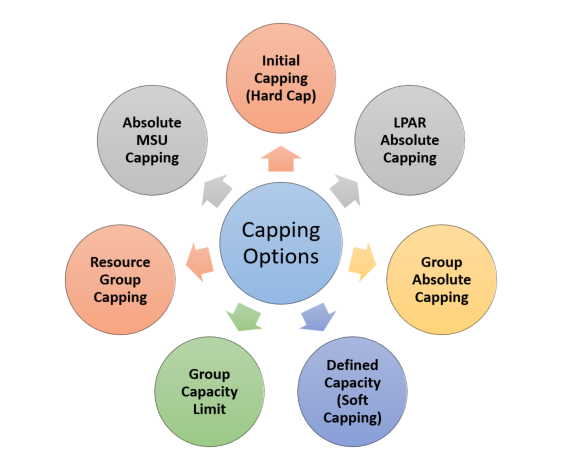Mainframe Caps for this Summer!
CMG imPACt 2017 – Call for Pre-Conference Volunteers
May 24, 2017Southwest CMG Virtual Meet-up! (CMG Webinar Series)
May 31, 2017Yes, mainframes have caps – several kinds and yes caps exist year around including summer!
Today’s mainframe run top industries mission critical workloads. This includes large financial institutions like banks, insurance companies, healthcare, utilities, government, military, and a multitude of other public and private enterprises.
The beauty of the mainframes lays in its flexibility, stability and security. Mainframe systems provide the ability to divide the resources of a single machine into multiple, logical partitions (LPARs), capable of running their own independent operating systems. These LPARs are, in practice, equivalent to separate mainframe systems themselves, and can function independently, or work together as a collection – called sysplex – that cooperate to process computing workloads. This sysplex design can run large commercial mission-critical workloads continuously and very efficiently.
Each mainframe machine has maximum central processing complex (CPC) capacity – the LPARs running on a given machine collectively use the machine’s CPC capacity. And capacity is the key word – mainframe systems have the equivalent processing power of multiple rows of multiple commodity servers – and have tremendous transaction throughput capacity. Much higher capacity than those banks of servers – which is why large organizations continue to use this platform – the mighty and majestic mainframe.
Given all these terrific capabilities, a question may also arise, is there a way to control mainframe, to be precise, LPARs?
There may be variety of reasons to control mainframe. For example, there may be a need to control cost with usage based software pricing models or you may want to limit the capacity of a test LPAR. These controls called “capping” comes in many forms that limits the CPU usage of an LPAR. Capping is managed either by Workload Manager (WLM) or PR/SM.
You can control mainframe at least in 7 different ways. Below we go through each one of them.

Initial Capping (Hard Cap)
The usage of CPC capacity of an LPAR is based on the weights that are defined in the Hardware Management Console (HMC). So each has partitions has its share of CPC capacity. However, if LPAR needs more than its share and other LPARs are not using their share then PR/SM allocates more capacity for the LPAR that needs more than its share.
Initial Capping (IC) also called hard capping setting prevents PR/SM from giving an LPAR more than its share even when there is capacity available in CPC. So an LPAR that has IC, can never exceeds its share. IC limit is defined in the HMC as relative weight.
Scope is single LPAR. This capping is managed by PR/SM.
LPAR Absolute Capping
LPAR absolute capping is PR/SM controlled capping limit that applies to single LPAR. Its limit is defined in the HMC as fractional number of processor. This capping is enforced independent of 4-hour rolling average(4HRA). This is capping is also suitable for non-z/OS partitions.
Scope is single LPAR. This capping is mange by PR/SM.
Group Absolute Capping
Group absolute capping similar to the LPAR absolute capping but applies to group of LPARs. Its limit is defined in HMC as a fractional number of processors. This capping is also controlled by PR/SM. The combined CPU capacity usage of these group of LPARs can never exceed the group absolute capping limit at any time.
Scope is group of LPARs. This capping is managed by PR/SM
Defined Capacity (Soft Capping)
The Defined Capacity (DC) value that LPAR needs to be controlled to, is set in HMC. WLM tracks the 4HRA and compares that against the DC value. 4HRA is the measure of the LPAR usage. If 4HRA exceeds DC value, then LPAR is capped. WLM triggers the capping but it is enforced by PR/SM. When this capping occurs, the work that supposed to be run on this LPAR gets be delayed. If the WLM policy is set right, then WLM will run the most critical work and delays the low important work. Capping will be in effect until the usage i.e. 4HRA drops below the DC value. At which point the LPAR functions normally. Since DC value is compared to the 4HRA average value, the current CPU usage of this LPAR can go over DC value as long as the average 4 hour rolling value doesn’t exceed the DC limit.
Scope is single LPAR. This means that DC value limits the CPU capacity for a single LPAR.
Limitation: DC only applies if LPAR has shared CPs. LPAR with dedicated CPs cannot be controlled by DC.
Good to know: Defined Capacity cannot be used with Initial capping control or vice versa. In other words, you could have any one of those but not both.
Group Capacity Limit
Similar to DC, group capacity limit(GCL) controls the CPU usage for a group of LPARs on a single CPC. In mainframes, z/OS LPARs can be grouped together called capacity groups. These LPARs should reside in same CPC but not necessarily same sysplex. GCL controls all LPARs in the capacity group. GCL value is set in HMC. The total 4HRA of all LPARs in capacity group cannot exceed the GCL value. If it exceeds the capacity group limit, then capacity group is capped by PR/SM and each member of the group gets its share based on its weight. Similar to DC, as the group 4HRA drops below the GCL, capping is removed. While 4HRA of the group is below GCL, each LPAR in the group can use the capacity it needs.
Within capacity group, in addition to its group share, each LPAR in the group can have DC. In such cases, minimum of calculated group share and DC is used to cap.
Scope is group of LPARs belonging to same CPC.
Resource Group Capping
Resource Group (RG) provides the ability to control the maximum and the minimum CPU capacity given to the service classes (workloads) that are connected to this RG. If workloads of RG exceeds the maximum limit, then WLM caps the CPU usage of RG.
WLM manages the workloads to the goals defined in the service definition. If a workload is missing its goal, then WLM try to help it by assigning more resources to it. In that process, WLM may take away resources from other workload that are meeting their goals. RG minimum and maximum values sets the limits to this CPU goal management. A Minimum prevents WLM from taking away resources and maximum prevents WLM giving more even if workload misses goal.
Scope is sysplex wide. That means the service classes that are in a RG should belong to the partitions that are in same sysplex. Partitions themselves can span multiple CPCs though.
Absolute MSU Capping
WLM controlled Absolute MSU capping is similar to PR/SM controlled initial(hard) capping. This is permanent capping controlled by WLM. The difference between them is, absolute MSU capping is specified in MSUs (DC of LPAR) whereas initial capping i.e. hard capping specified in relative weight.
The limit value is derived from DC and LPAR group capacity. This capping is activated in the parmlib member IEAOPTxx with the option AbsMsuCapping = YES.
Scope is single LPAR.
Summary
Mainframe systems provide tremendous capabilities, and run the world’s largest and most complex commercial workloads. Yet it remains highly flexible, and is able to handle the unique business needs and workloads required for a wide range of businesses. To facilitate this high degree of business flexibility, there are exist at least 7 different techniques available to control the mighty and majestic mainframe.
Author: Hemanth Rama is a senior software engineer at BMC Software. He has 11+ years of working experience in IT. He holds 1 patent and 2 pending patent applications. He works on BMC Mainview for z/OS, CMF Monitor, Sysprog Services product lines and has lead several projects. More recently he is working on Intelligent Capping for zEnterprise (iCap) product which optimizes MLC cost. He holds master degree in computer science from Northern Illinois University. He writes regularly on LinkedIn pulse, BMC communities and his personal blog.




